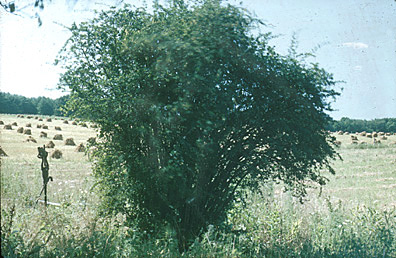Puccinia graminis (Stem wheat rust)
Introduction

By Rafael Contreras Rangel
Wheat stem rust, also known as black rust, is caused by the fungus Puccinia graminis and it has recently acquired much attention due to the danger it displays to the global wheat productions in the near future. Although wheat stem rust is not the most common rust disease of wheat rust, with wheat leaf rust being the most common, it certainly currently is the most dangerous (Signh, et al 2008).
Wheat resistance to stem rust was largely believed to be held in the gene Sr31 (Pretorious et al., 2000). But on February 1999, large amounts of stem rust were observed in Uganda’s wheat plantations (2000). After running studies for the resistance in wheat for stem rust, it was found that a new strain of stem rust had mutated, making the resistance to stem rust that was found in Sr31 obsolete. This new strain of stem rust was name Ug99 due to its country of origin and the year it was discovered.
Not only does Ug99 carry virulence to gene Sr31, but overtime it has also mutated to be resistant against most variations of stem wheat rust resistance that originated in wheat itself (Singh et al., 2008). Due to this fact, genetic engineering has started to be employed in order to try and find resistance genes in species closely related to wheat. These genes could then be transferred to wheat and give it resistance against the different variations of Ug99 as well as other different races of wheat rust.
It is extremely important to find a way to stop the expansion of Ug99. Although the exact route of expansion of the Ug99 strain is unknown, models have given it the trajectory to reach India, whose wheat production is one of the highest in the world (Figure 1). It has been estimated that 85% of the global population require wheat as one of their only calorie sources (Singh et al., 2008). If a way to stop the Ug99 strain is not found, one of the world’s largest sources of wheat could be destroyed, and it would bring a major food scarcity problem down with it.
Disease Cycle

Puccinia graminis is an obligate parasite, meaning that it requires living in another organism, benefiting from it while the host organism is usually being stressed or eventually killed in the process. P. graminis is also heteroecious, which means that the fungus requires living in two distantly related species throughout its life cycle. These two distantly related species that stem wheat rust requires are wheat and barberry plants (Schumman and Leonard, 2000). Barberries are a type of shrub that is either deciduous or evergreen, and it can be found in temperate and subtropical regions (Figure 2). While the best mode of reproduction for P. graminis is by completing its life cycle in both wheat and barberry, it can still grow without having to infect the barberry by acquiring aeciospores from other regions (Schumann and Leonard, 2000).
The life cycle of the stem wheat rust starts by the introduction of either an aceciospore or a urediniospore to a wheat plant. The spores can either come from a distant region carried by the wind, from barberry, the alternate host, or from the wheat plant itself if it is already infected. The pathway cycle that the disease will take depends on the region where the wheat is being grown. Temperate regions mostly only grow wheat during the springs since the winters are too cold for wheat to grow. So the plants in temperate regions may either be exposed to aeciospores from barberry or from uredinospores being carried by the wind from the south, where wheat is grown year-round or just at an earlier time than the wheat in the north (Schumann and Leonard, 2000).
Section 2
Include some current research, with at least one figure showing data.
Section 3
Include some current research, with at least one figure showing data.
Conclusion
Overall text length at least 3,000 words, with at least 3 figures.
References
Edited by student of Joan Slonczewski for BIOL 238 Microbiology, 2011, Kenyon College.
